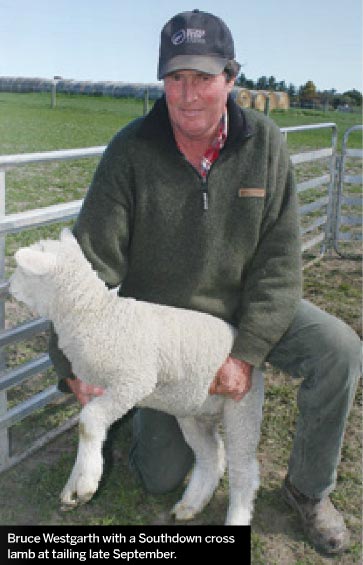SOUTH CANTERBURY sheep and beef farmers the Westgarths run 4000 Coopdale ewes across two farms, one at 500m above sea-level on The Brothers range inland of Timaru, the other on the town’s outskirts.
“The two properties work so well together,” says Bruce, who runs the inland unit with wife Rosa. “We take all the older ewes down to Timaru where we put them to terminal sires: Southdown, Poll Dorset and Suffolk. We’ve had Southdowns for years. They produce good lambs, and early maturing.”
Nearly half the ewes on the 200ha down-country farm, which is run by their son Hamish and his wife Amanda are put to Southdowns, plus 300-400 at the 368ha Brothers property.
Replacements come from Coopdale hoggets, 1250 of which were run with the ram last autumn, with 1000 scanned inlamb.
While he’s well placed to do so, Westgarth’s wary of comparing performance of the different terminal sires he uses. “There’s good in all breeds.”
Most have made marked improvements in recent years and the Southdown is no exception. The short, stumpy lambs prone to running to fat if taken too heavy are long gone. In their place are rams which throw a longer, leaner lamb that’s still solidly built and fast finishing.
“Some people still have the wrong impression of them,” notes Westgarth. “They still think they’re wee fat things, though views are starting to change now.”
The growth of his Southdown x Coopdale lambs is rapid. Last year they started lambing August 22 and in the last week of November drafted 230, averaging 19.8kg.
“They always weigh heavier than they look.”
Admittedly, there were other breeds among them, but the Southdown at least held its share, if not more. Over the whole season, and all breeds, average kill weight was 20.3kg cwt.
“We drafted lambs every week from the end of November through to May.”
Getting more lambs away early, plus an end of season contract for the last 2000, helped them average $136/head “without counting the wool off them.”
As a rule they’re shorn at 38kg and go on the truck at 44kg, all to Silver Fern Farms.
Picks breeder more than ram
WESTGARTH’S APPROACH to ram selection is simple: find good breeders, stick with them and reward them.
“I don’t mind paying a good price for good rams because if the breeder can’t make money, they can’t improve the genetics can they?”
His three suppliers are all from South Canterbury. The Southdowns come from Chris Medlicott’s Tasvic Downs and Clifton Downs studs; the Poll Dorsets from Steve McCall’s Castlerock stud, and the Suffolks and Coopdales from Peter Darling’s Coryston Stud.
Westgarth points out better prices for the lambs isn’t the only benefit to early finishing: their mothers make better money as cull ewes.
“We try to get them on the truck the next day.”
Space freed up on the down-country farm also allows more lambs and other stock to come down from The Brothers. With no irrigation, both properties can get dry. Again, fast growing, early finishing lambs are an advantage, in that more are gone before feed gets tight.

